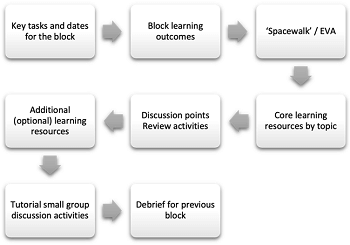HHiSE Curriculum: Space Health Education for MD Students at the University of Melbourne (Australia)
Main Article Content
Abstract
Background: Since 2022, the University of Melbourne’s 4-year MD program has integrated a "Discovery" subject stream with core subjects and clinical placements. "Human Health in the Space Environment (HHiSE)"—one of seven MD1 flagship topics—launched in March 2022; the author curated its content and co-developed an engaging interactive online curriculum with learning designers via the flipped classroom approach.
Description: This 24-week "mission-based" course is divided into systems-based blocks (e.g., Foundation, Cardiovascular, Respiratory). Students learn through "spacewalks" (learning resource sets), interactive tutorials, "Meet an Expert" virtual lectures, and the NASA/LEGO "Build to Launch" program (for teamwork training). It also explores "Space4Health" and translational space health research via "spinoffs," with three assessments focused on building students’ public science communication skills.
Discussion: This innovative course introduces students to human physiology in extreme environments and aerospace medicine, serving as a stepping-stone for training a space-enabled medical workforce. Its foundational template could be expanded to more space health subjects, adapted for public online access, or used for international collaborations to develop similar courses.
Article Details
References
- Center for Space Medicine. (2025). Space Medicine Education. Baylor College of Medicine (BCM). https://www.bcm.edu/academic-centers/space-medicine/education
- Hew, K. F., & Lo, C. K. (2018). Flipped classroom improves student learning in health professions education: a meta-analysis. BMC Medical Education, 18(1). https://doi.org/10.1186/s12909-018-1144-z
- LEGO Education. (2024). Build To Launch: A STEAM Exploration Series In collaboration with NASA and the Artemis I Mission. https://education.lego.com/en-us/build-to-launch
- Medical Deans Australia and New Zealand. (2025). Data Dashboard. https://medicaldeans.org.au/data
- Melbourne Medical School. (2022). Towards 2022: The new Doctor of Medicine. The University of Melbourne. https://medicine.unimelb.edu.au/news-and-events/towards-2022-the-new-doctor-of-medicine
- Melbourne Medical School. (2024). MD Discovery. The University of Melbourne. https://medicine.unimelb.edu.au/school-structure/medical-education/study/md-discovery#overview
- The textitad astra vita project. (2024). Human Health in the Space Environment -- `Meet an Expert' talks. https://www.youtube.com/playlist?list=PL4PAynk-yILu0NxQcB9D4IfcV1B8Cc29B
- The University of Melbourne. (2025). MD Discovery 4: Research Scholar (MEDS90044). The The University of Melbourne. https://handbook.unimelb.edu.au/subjects/meds90044
- University of Melbourne. (2024). Doctor of Medicine. https://study.unimelb.edu.au/find/courses/graduate/doctor-of-medicine/structure/#nav
- University of Melbourne. (2025). Rural Pathway to the Doctor of Medicine. https://study.unimelb.edu.au/lp/mdhs/md-rural-pathway
- University of San Diego Professional and Continuing Education. (2024). What is a MOOC? [Explained + 6 Point Guide]. University of San Diego. https://pce.sandiego.edu/what-is-a-mooc-explained- 6-point-guide
- UTMB Health. (2024). Aerospace Medicine Medical School Concentration. https://www.utmb.edu/spph/aerospace-medicine/asm-concentration



